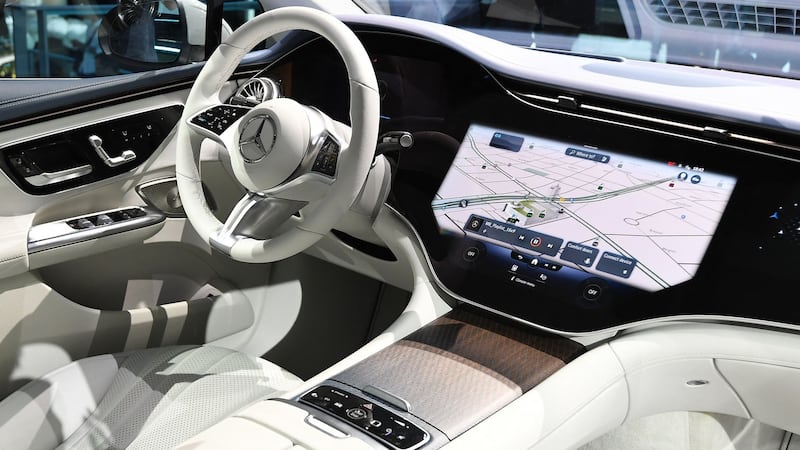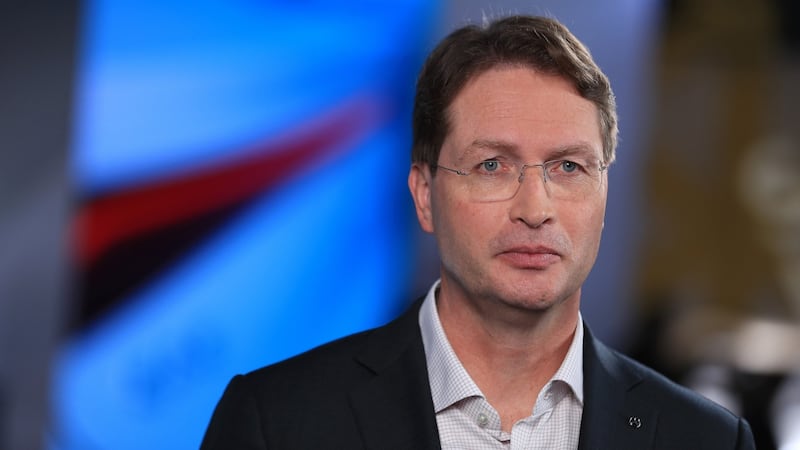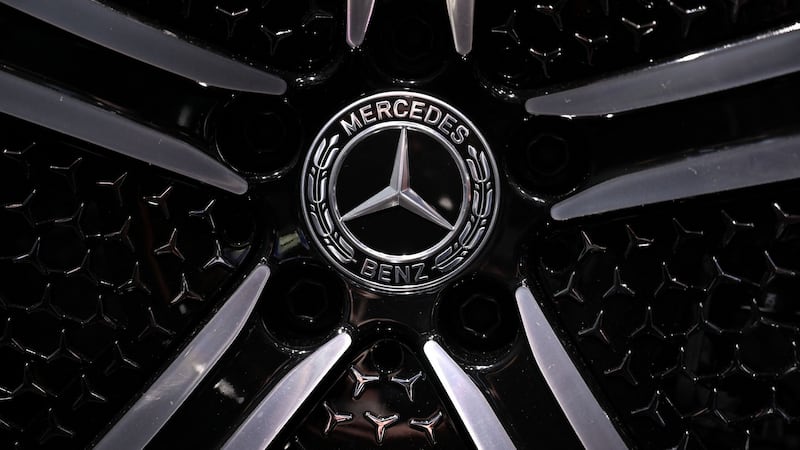Mercedes-Benz has rolled out several all-electric models in recent years, but there is still something of a landmark to the arrival of an E-Class electric car, christened the EQE.
It’s part of a commitment made by the German luxury brand that from 2025 it will only develop new models with all-electric capability, and that every model in its lineup will be offered with at least one fully-electric version.
Revealed at the IAA motor show in Munich, and due on sale in Ireland next March, the EQE is every inch the battery-powered E-Class. Mind you, under that swoopy skin it actually has more in common with the recently-launched electric EQS - riding on the same platform, using much of the same infotainment and battery technology.
0 of 3
Range
That battery has a 90kWh capacity, which on a full charge will give you a range of up to 660km says Mercedes. On top of that, the EQE can be recharged at speeds of up to 170kW from a high-power DC charger. That allows you to add as much as 250km for every 15-minutes spent on a public charging point.
Mercedes claims that the EQE’s electric drive system can cope with high speeds and repeated acceleration runs without suffering drops in power, or needing to slow down to allow the battery to cool. There’s also selectable electric braking modes (so you can call-up ‘one-pedal’ driving for city mileage, for example).
The first model launched will be the EQE 350, which gets a 292hp, 530Nm of torque electric motor driving only the rear wheels. Mercedes says that a second model will be launched alongside that 350, but gnomically isn't giving any more details than that, although Stuttgart has confirmed that there will be four-wheel drive, two-motor 4MATIC models in the future. That single motor, claims Merc, has been designed to minimise any noise or vibration, and has even been surrounded with noise-absorbing foam for maximum silence.
Underneath, you can have a choice of conventional steel suspension, lifted broadly from the S-Class, or optional air springs, with adaptive electronic dampers. There’s even optional rear-wheel steering, which cuts the EQE’s turning circle down to a London Taxi-like 10.7-metres.
Style-wise, the EQE looks very similar to the larger EQS, although it’s shorter overall, a little lower, and has an 88mm shorter wheelbase. That’s still some 80mm longer in the wheelbase than the current E-Class saloon, though, and the EQE has more interior width too. Oddly, though, the boot is somewhat small for a car of this size - just 430-litres. Mercedes has clearly been prioritising passenger space over cargo.
Cabin pressure

While base models will come with a relatively simple dashboard, higher-spec versions will get the enormous 1.4-metre width MBUX Hyperscreen electronic dashboard. This stretches from one side of the cabin to the other, with the round air vents as little islands in an apparently unbroken stretch of screen. Actually, it’s really a big cover over three separate, huge, screens - one for the driver, one for the infotainment system in the middle, and a third for the front-seat passenger. That passenger can, apparently, even stream movies or TV onto their screen.
Sounds distracting? Mercedes has thought of that - there’s an eye-tracking system that checks if the driver is getting drowsy, but can also tell if they’re focusing on the passenger’s content, and will dim that screen by way of scolding an inattentive driver.
There’s also an active sound system that, if you spec up the expensive Burmester stereo, plays driving noises into the cabin. They come in three themes - ‘Silver Waves’ and ‘Vivid Flux’ are standard, and the third - ‘Roaring Pulse’ - can be downloaded via the over-the-air software update system.
All-electric future
As for the commitment to electric models form 2025, considering that most other European car makers have committed to something similar, within a broadly similar timeline, that may not sound like the most shocking news ever.
However it is certainly significant - the company that gave us the first truly useable liquid-fuelled car (paraffin, rather than petrol, but still) in 1886, and which actually helped Nicolaus Otto create the first successful four-stroke piston engines (hence, Otto Cycle for the four-stroke engine) will in pretty short order be selling a majority of its cars with electric power.

“The EV shift is picking up speed - especially in the luxury segment, where Mercedes-Benz belongs. The tipping point is getting closer and we will be ready as markets switch to electric-only by the end of this decade,” said Ola Källenius, of both the Mercedes brand, and the parent company Daimler-Benz. “This step marks a profound reallocation of capital. By managing this faster transformation while safeguarding our profitability targets, we will ensure the enduring success of Mercedes-Benz. Thanks to our highly qualified and motivated workforce, I am convinced that we will be successful in this exciting new era.”
Multi-billion euro investment
Mercedes is going to invest heavily in this switch to electric power, pumping in some €40 billion between next year and 2030. From 2025, Mercedes will launch only fully-electric new models, and those will be based around three basic vehicle architectures. There will be an MB.EA platform, designed to support medium-to-large passenger vehicles, and an AMG.EA platform designed specifically for AMG-badged high-performance vehicles.
There will also be a VAN.EA specially designed for commercial vehicles. Mercedes says that it will buy the UK-based electric motors manufacturer, YASA, along with its cutting edge axial flux motor technology.
There will also be a ramping-down of developments of plugin-hybrids, in spite of Mercedes having just launched a new range of long-range PHEV models, which can drive on electric-only power for up to 100km. The company’s accountants reckon that investments into combustion engines and plug-in hybrid technologies will drop by 80 per cent between 2019 and 2026.

Mercedes will also start making its own batteries, and is planning to break ground on as many as eight so-called ‘Gigafactories’ for battery production around the world. These eight factories are expected to have a total production capacity of some 200-gigawatt/hours - enough for more than three-million cars, if you assume an average of 60kWh battery packs for each vehicle.
Factories
While it might be tempting to build all eight of those factories in low-cost Asian locations, Mercedes has said that it "intends to team up with new European partners to develop and efficiently produce future cells and modules, a step which ensures that Europe remains at the heart of the auto industry even in an electric era." The batteries it is planning to make will be modular, and easily shared across the entire new electric Mercedes lineup. On top of which, it's working with battery development experts SilaNano to create new higher-energy density, faster-charging batteries based around current technology, as well as working on next-generation ultra-fast charging solid-state batteries.
There will also be a new 'Plug and Charge' system rolled out, which will allow Merc drivers to hook up for a charge at most public charging points without having to download any extra apps nor keep extra RFID cards in the car. Mercedes is a founding partner of the IONITY high-speed charging network, which helps, but it's also teaming up with Shell, to give Mercedes buyers access to that company's 30,000-strong European charging network.
There’s not much point in making all these electric cars if the factories in which you build them are going to be belching out smoke and carbon, so Mercedes has also said that from 2022 all passenger car and battery assembly sites that it runs will switch to carbon neutral production.
As part of all these plans, there will have to be some juggling of Mercedes' workforce. Merc is already ramping up its re-training efforts, saying that 20,000 employees in Germany last year were trained in aspects of e-mobility. It expects that around 3,000 new software engineering jobs will be created worldwide as part of the creation of a new in-car software system, but that there will also have to be some "early retirement as well as buyouts."

















